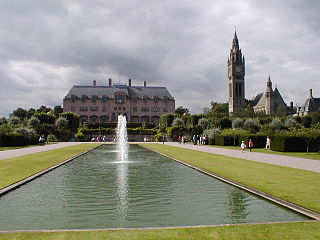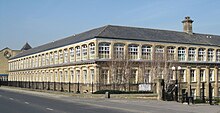
Lyme Park is a large estate south of Disley, Cheshire, England, managed by the National Trust and consisting of a mansion house surrounded by formal gardens and a deer park in the Peak District National Park. The house is the largest in Cheshire, and is recorded in the National Heritage List for England as a designated Grade I listed building.

Weetwood is an area between Headingley and Meanwood in north-west Leeds, West Yorkshire, England. It is bounded on the north by the A6120, on the west by the A660, on the east by Meanwood Beck and to the south by Hollin Lane. Weetwood Lane runs north and south through it.

Meanwood is a suburb and former village in north-west Leeds, West Yorkshire, England.

Eaton Hall is the country house of the Duke of Westminster. It is 1 mile (2 km) south of the village of Eccleston, in Cheshire, England. The house is surrounded by its own formal gardens, parkland, farmland and woodland. The estate covers about 10,872 acres (4,400 ha).

Bodington Hall was the largest hall of residence of the University of Leeds, in Leeds, England. It was opened in 1961 and closed in 2013. The site still contains the university's main playing fields. Known as Bod within the university, it was located between Lawnswood and Adel, approximately 4 miles north of the main campus. Bodington was used mainly to house first year undergraduate students. Out of term, it was used for conferences and sporting activities such as WorldNET, the Internet Football Association's annual tournament, and from 1994 to 2012 it was the venue for the International Medieval Congress (IMC).

The Meanwood Beck is a stream in West Yorkshire, England, which flows southwards through Adel, Meanwood and Sheepscar into the River Aire in central Leeds. Different portions of the same watercourse have been referred to as Adel Beck, Carr Beck, Lady Beck, Mabgate Beck, Sheepscar Beck, Timble Beck or Wortley Beck. The Meanwood Valley Trail footpath follows the line of the beck for much of its course.

Armley Park is a large public park located next to Stanningley Road in Armley, on the outskirts of Leeds, in West Yorkshire, Northern England.

Carr Manor is a Victorian grade II listed house in Meanwood, Leeds, England, designed by Edward Schroeder Prior and built for Thomas Clifford Allbutt (1836–1925). In 1881 it replaced Carr Manor House, though retaining the 1796 stable block. The former gardener's and housekeeper's cottages, the former stables and the wall, gate piers and gates are also grade II listed.
There are 212 Grade II* listed buildings in Bristol, England.

This is a list of halls of residence both on and off campus at the University of Leeds in Leeds, England.

The Welsh Presbyterian Church is in St John Street, Chester, Cheshire, England. The church was built in 1866, and designed by W. & G. Audsley of Liverpool. It is constructed with a yellow sandstone front, brick sides and rear, and a slate roof. The plan consists of a simple rectangle, with an apse at the east end, and a narrower single-storey narthex at the west (entrance) end. The narthex is supported by octagonal piers at the corners and two granite columns between them. On each side of the narthex is a lancet window. Above the narthex is a large rose window, with a lancet window above, and a cross finial on the gable. The church is recorded in the National Heritage List for England as a designated Grade II listed building. The wall and the iron railings and gates in front of the church are included in the listing.
William Hill was an English architect who practised from offices in Leeds, West Yorkshire, England.
Temple Sowerby is a civil parish in the Eden District, Cumbria, England. It contains 42 listed buildings that are recorded in the National Heritage List for England. Of these, one is listed at Grade I, the highest of the three grades, one is at Grade II*, the middle grade, and the others are at Grade II, the lowest grade. The parish contains the village of Temple Sowerby and the surrounding countryside. Most of the listed buildings are in the village, and consist of houses and associated structures, farmhouses and farm buildings. Also in the village and listed are a public house, a telephone kiosk and a maypole. Outside the village, and listed, are Acorn Bank House and a water mill, both with associated structures.
Bingley is a civil parish in the metropolitan borough of the City of Bradford, West Yorkshire, England. It contains 102 listed buildings that are recorded in the National Heritage List for England. Of these, one is listed at Grade I, the highest of the three grades, six are at Grade II*, the middle grade, and the others are at Grade II, the lowest grade. The parish contains the town of Bingley and the surrounding countryside to the north, east and south, including the villages and settlements of Cottingley, Eldwick, Gilstead, and Micklethwaite.
Chapel Allerton is a ward in the metropolitan borough of the City of Leeds, West Yorkshire, England. It contains 72 listed buildings that are recorded in the National Heritage List for England. Of these, one is listed at Grade II*, the middle of the three grades, and the others are at Grade II, the lowest grade. The ward is to the north of the centre of Leeds, and includes the areas of Chapel Allerton, Chapeltown, and Potternewton. Most of the listed buildings are houses and associated structures. The other listed buildings include churches, chapels and a synagogue, some of which have been converted for other uses, memorials in a graveyard, a packhorse bridge, public houses, a windmill converted into a house, former mill buildings, a former tannery converted for residential use, a school, public buildings, and two war memorials.
Headingley is a ward in the metropolitan borough of the City of Leeds, West Yorkshire, England. It contains 111 listed buildings that are recorded in the National Heritage List for England. Of these, two are listed at Grade II*, the middle of the three grades, and the others are at Grade II, the lowest grade. The ward is to the northwest of the centre of Leeds, and is largely residential. As Leeds became more prosperous in the 19th century, the area developed to become "the prime residential area of Leeds". Most of the listed buildings are houses and associated structures, many of the houses are large, and some were used later for other purposes. The other listed buildings include churches and associated structures, public houses, remaining structures from the Leeds Zoological and Botanical Gardens, a cinema and lamp post, a war memorial, and a group of telephone kiosks.
Hyde Park and Woodhouse are areas in the metropolitan borough of the City of Leeds, West Yorkshire, England. The areas contain 146 listed buildings that are recorded in the National Heritage List for England. Of these, five are listed at Grade II*, the middle of the three grades, and the others are at Grade II, the lowest grade. The areas are largely residential, and also contain the University of Leeds. Many of the university buildings are listed, some of which are newly built, and others have been converted from pre-existing buildings. Most of the other listed buildings are houses and associated structures, and the rest include churches and memorials in churchyards, a public house, statues and other memorials, buildings in the former Woodhouse Cemetery, schools and associated structures, a cross, and public buildings.
Moortown is a ward in the metropolitan borough of the City of Leeds, West Yorkshire, England. It contains 36 listed buildings that are recorded in the National Heritage List for England. All the listed buildings are designated at Grade II, the lowest of the three grades, which is applied to "buildings of national importance and special interest". The ward is to the north of the centre of Leeds, and contains the suburb of Moortown, the former village of Meanwood, and part of Moor Allerton. Most of the listed buildings are houses, cottages, and associated structures. The other listed buildings include a column, a well cover, former mill buildings, a church and a chapel and associated structures, a boundary stone, schools, and a war memorial.
Roundhay is a ward in the metropolitan borough of the City of Leeds, West Yorkshire, England. It contains 50 listed buildings that are recorded in the National Heritage List for England. Of these, one is listed at Grade II*, the middle of the three grades, and the others are at Grade II, the lowest grade. The ward is to the northeast of the centre of Leeds, and includes the suburbs of Roundhay, Gledhow, and Oakwood. The ward is mainly residential, and most of the listed buildings are houses, cottages and associated structures, farmhouses and farm buildings. The other listed buildings include an open-air bath, a bridge, schools, a hotel, churches and a gravestone in a churchyard, a folly, a row of almshouses, a hospital, a drinking fountain, a shop, and a clock tower.
Weetwood is a ward in the metropolitan borough of the City of Leeds, West Yorkshire, England. It contains 78 listed buildings that are recorded in the National Heritage List for England. Of these, four are listed at Grade II*, the middle of the three grades, and the others are at Grade II, the lowest grade. The ward is to the northwest of the centre of Leeds, and includes the suburbs of Far Headingley, Ireland Wood, Tinshill, Weetwood and West Park. It is mainly residential, and most of the listed buildings are houses, some large and divided into smaller units, with associated structures. The ward also includes Leeds Beckett University, many of whose buildings are listed. The other listed buildings include a column originally in a church, shops, a public house, a horse trough, churches, a meter house, a former hospital, a post box, and a war memorial.











